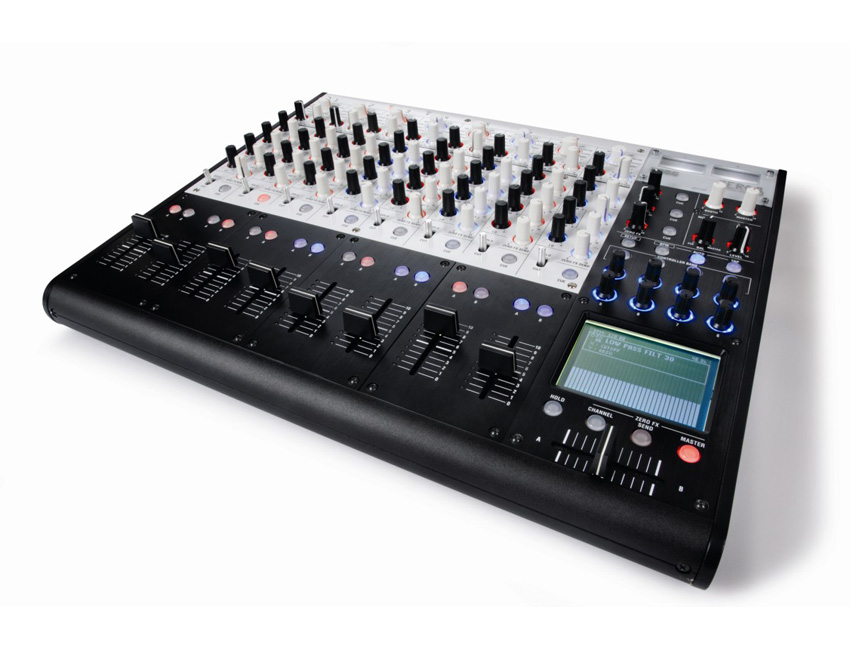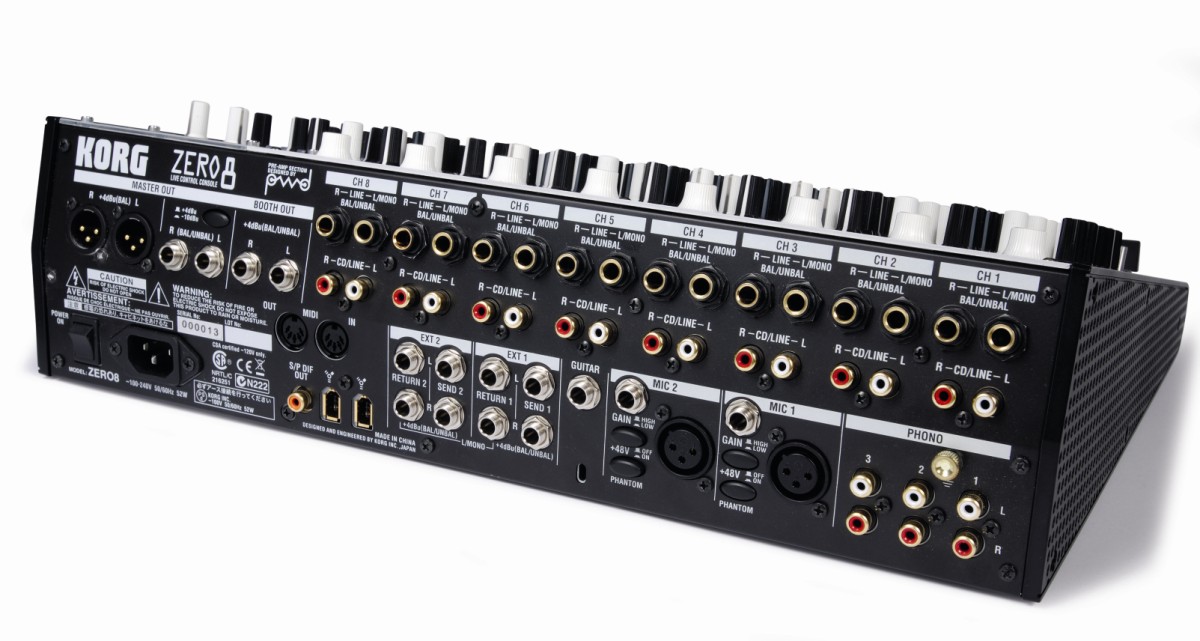MusicRadar Verdict
DJs and live laptop-ers rejoice; studio dwellers wave farewell to your mice: it´s hands-in-the-air time.
Pros
- +
Huge array of inputs. Intuitive touch-pad control. Reconfigurable controls.
Cons
- -
Touch-pad could be a little brighter.
MusicRadar's got your back


Every once in a while, it´s worth pausing to note how there´s less equipment packed into the average studio these days when compared to its counterpart of five years ago. Many of the MIDI synths have gone, along with the effects processors and DAT machines, leaving a hefty computer and bloated plug-in folder in their wake, possibly flanked by a nice mic pre, copious external drives and a decent set of monitors.
While this has made life easier on many levels, it´s also true that a new hardware counter-culture is under way. Traditional manufacturers have been forced to think on their feet and start offering products relevant to this digital age. Korg are one company that fall squarely into this category - they´re among the first of the ‘majors´ to offer their synth classics in plug-in form with the release of their Legacy Collections.
They also developed the Kaoss Pad, a real-time effects controller that sits beautifully alongside a laptop. And now they´re at it again, this time attempting to reinvent the mixer. So welcome to the Zero8 Live Control Console - a mixer, FireWire audio interface, MIDI controller and real-time effects processor in one tidy package.
Overview
Despite boasting such a range of features, the Zero8 is first and foremost a mixer. The top panel features eight input channels, each of which can choose from a variety of input sources (more on this in a moment). Beneath these, each channel features a gain control, EQ selector knob, EQ and pan controls, three effects sends, a cut/solo toggle switch, and, lastly, a cue button.
Below these, ‘A´ and ‘B´ LED switches lie above a DJ mixer-style level fader. To the right of the front panel, in the master section, you´ll find a touchscreen LCD display and a selection of rotary dials and buttons, which access more global controls for effects levels, MIDI controllers and output levels, among other things.
In the top right-hand corner, stereo VU meters keep you in touch with output levels. The all-important DJ crossfader lies in the bottom right-hand corner, allowing you to switch back and forth between ‘A´ and ‘B´ busses, whose audio content is assigned by a simple press of the relevant button at the bottom of each channel strip.
Inputs
But this ain´t the half of it. The rear panel gives much more insight into the potential of this device, as it´s loaded with input possibilities. There are three sets of phono inputs, so a trio of turntables potentially lie in wait. Then you´ll find two XLR mic inputs with independent phantom power switches and gain pads. In case your mic sources are dynamic, separate quarter-inch mic ins are also available, with a high/low gain toggle switch.
Next, a dedicated guitar input, followed by two sets of stereo line ins per channel (16 each in total), with both quarter-inch line ins and CD-player RCA connectors available here. As far as outputs go you´re all set too, with independent balanced outs available in both XLR and line form, alongside separate line level outs for your DJ booth monitoring.
There´s even an S/PDIF digital output that matches the analogue out´s level but allows you to feed the whole mix caboodle to a DAT machine, computer or other digital source, should the desire arise. The remaining connectors concern themselves with connectivity; namely, the two FireWire ports and MIDI In/Out, both of which lead us rather neatly to what happens when you turn this monster on.
Simple
Once you´ve recovered from the Zero8´s power-up light show, it soon becomes apparent how joyous this unit is. At the top of each channel strip, a rotary dial allows you to select the input you´d like to use, with the three phonos, two mics, guitar, line, audio, audio and MIDI and MIDI your available choices.
The first half should be relatively self-explanatory. Make your rear-panel connections, use the dial to select the relevant ports and the signal will bomb down the channel. What might be less obvious are the FireWire and MIDI choices. The FireWire ports act as an audio interface - you can connect this to your laptop and receive audio from your laptop as a signal source and/or use the Zero8 as an audio source to record sounds to your computer.
A PC audio driver ships on the accompanying CD (plug and play on the Mac), and then you´re off. Integration couldn´t really be any simpler. Once you´ve picked your audio source of choice the signal continues down a familiar route, with three-band EQ available on each channel complete with sweepable mid, a pan dial and three effects send dials. The first two of these allow you to send signals to external processors, while the third provides access to the Zero8´s comprehensive internal effects system, of which more shortly.
So what´s the MIDI rotary setting for? Well, set your input source here and all the dials present in the channel strip turn into MIDI controllers, bunging out user-defined MIDI messages. The bundled CD contains Korg´s ZeroEdit software, which lets you configure the dials to the controllers of your choice, so regardless of the instruments you want to control, you should have no problem matching your favourite parameters to any given dial.
To top it all, switching from one of the audio sources to MIDI changes the given channel from red LEDs to blue ones, so you can tell at a glance how each channel is configured. Ingeniously, any audio source sent to a channel switched to MIDI mode will still route its signal to the master output - you just can´t control its input level. In ‘FireWire Audio + MIDI´ mode, the FX send controls act as MIDI controllers while continuing to provide audio access to the EQ and pan dials.
Interfaced
So does this chap do the job as an audio interface? Yes. The first three channel ‘cue´ buttons double as start-up sample rate selectors, with Cue button 1 booting the unit at 44.1kHz, button 2 at 48kHz and button 3 offering 96kHz. The sonic superiority of the latter option does, however, come at some processing cost, with the in/out audio options halving from 16 to 8, channel EQ being bypassed altogether and all effects unavailable..
If your studio requirements stretch this far, it´s likely you´d want the Zero8 to act as little more than an audio interface in its own right. At 44.1kHz or 48kHz, however, all functionality returns and 16 inputs and outputs are offered for recording and playback. The mic pres sound clean and do a perfectly reasonable job, and it goes without saying that this is a phenomenal unit for studio musicians keen on gathering sample material from various different sources.
Effects
The Zero8 comes stacked with effects too, much of whose processing is lifted from the wonderful Kaoss Pad series. Three separate effects processors can run simultaneously, with one effect assignable in-channel, another accessible via an internal buss send and a third can be attributed to the whole mix at the master stage. The Zero8 makes setting these up a doddle.
You simply choose the effects ‘stage´ you want to assign and then use the rotary encoders above the LCD screen to choose an effect and tweak its parameters or (better still) simply ‘perform´ your effects in real time using the screen itself.
Anyone who´s played with a Kaoss Pad will understand this concept immediately. But in case you´re a Kaoss virgin, it works like this: Korg´s Kaoss technology allows you to assign effects parameters to the screen so it becomes an effects control surface. Suppose you have a resonant filter effect, you can assign cutoff to the X-axis (for example, left-to-right movements) and resonance to the Y-axis (up-and-down). Then, simply touching the screen and dragging your fingers back and forth will apply that effect to your mix. Seeing Kaoss Pad technology implemented here is just fantastic.
The filter effects, phasing, jet flangers and the like will appeal to record-playing DJs, whereas the loop and hold possibilities will appeal to laptop live musicians who want to build arrangements in real time. There´s sufficient scope in terms of effects programs for this to be relevant technology to sound designers and more intuitive producers too.
Perfect
No piece of kit is perfect but it´s fair to say that the Zero8 comes close. The channel faders could be stiffened slightly - they're wonderfully loose and can be thrown around and toggled up and down quickly, but they´re so responsive that a hard fader throw from bottom to top is actually capable of rebounding if you get a bit over-enthusiastic. And a colour touch-pad would be great. But these are just ideas for enhancements, not deal-breakers.
Make no mistake, the Zero8 is a hit of seismic proportions. Korg have thought this piece of kit through very carefully, and if you don´t find the results creative and intuitive, then you need the motherboard in your brain tweaked.
For starters, having such an array of input possibilities means that you can connect everything but the kitchen sink to this instrument and the Zero8 will incorporate it into your live set or mix, or pipe it straight to your computer down a FireWire cable.
Factor in the ability to turn any input strip into a MIDI controller at the turn of a dial and you immediately have access to an even wider range of potential sound sources. And if that´s not enough for you, the Kaoss-style effects processors - complete with real-time control - should be enough to ensure that individual channels or even the whole mix remains liquid and tactile from the first moment of your set to the last.
The Zero8´s ergonomic setup and bright LEDs keep you in touch with mix settings without further thought and the time between unpacking the box and making interesting live music is satisfyingly short. If you´re looking for a device to make your live setups more creative, or a studio tool to remove the mouse-driven ethos from music making, get to your local retailer to try the Zero8. And don´t forget your wallet!
MusicRadar is the number 1 website for music makers of all kinds, be they guitarists, drummers, keyboard players, djs or producers...
GEAR: We help musicians find the best gear with top-ranking gear round-ups and high- quality, authoritative reviews by a wide team of highly experienced experts.
TIPS: We also provide tuition, from bite-sized tips to advanced work-outs and guidance from recognised musicians and stars.
STARS: We talk to musicians and stars about their creative processes, and the nuts and bolts of their gear and technique. We give fans an insight into the actual craft of music making that no other music website can.
With its latest free update, Ableton has finally turned Note into the app I always wanted it to be
Technically capable, but struggle to make your tunes sound musical? 5 simple music theory hacks to make your tracks stand out
"Despite its size, it delivers impressive audio quality and premium functions as well as featuring a good selection of inspired sounds": Roland GO:Piano 88PX review










